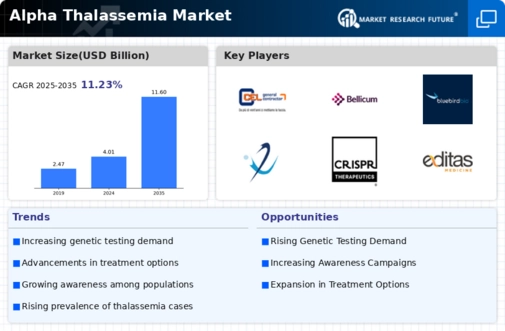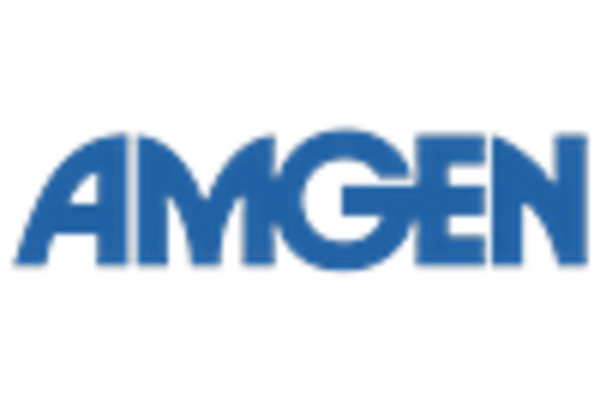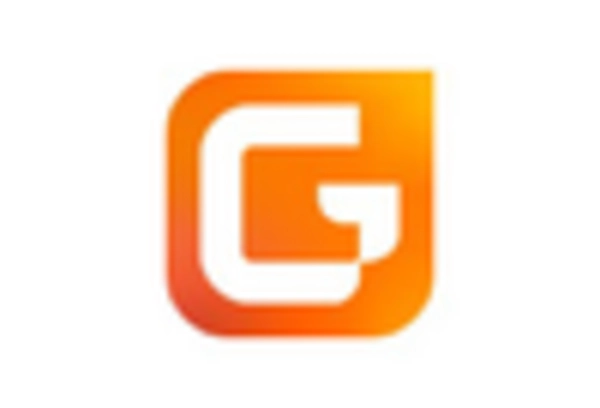-
Definition
-
Scope of the Study
- Research Objective
- Assumptions
- Limitations
-
Introduction
-
Primary Research
-
Secondary Research
-
Market Size Estimation
-
Drivers
-
Restrains
-
Opportunities
-
Challenges
-
Macroeconomic Indicators
-
Technology Trends & Assessment
-
Porter’s Five Forces Analysis
- Bargaining Power of Suppliers
- Bargaining Power of Buyers
- Threat of New Entrants
- Threat of Substitutes
- Intensity of Rivalry
-
Value Chain Analysis
-
Investment Feasibility Analysis
-
Pricing Analysis
-
Chapter 6. Global Alpha Thalassemia Market, By Type
-
Introduction
-
Hb Bart syndrome
- Market Estimates & Forecast, 2020 – 2023
-
HbH disease
- Market Estimates & Forecast, 2020 – 2023
-
Silent carrier state
- Market Estimates & Forecast, 2020 – 2023
-
Trait
- Market Estimates & Forecast, 2020 – 2023
-
Chapter 7. Global Alpha Thalassemia Market, By Diagnosis
-
Introduction
-
Perinatal testing
- Market Estimates & Forecast, 2020-2027
- Complete blood count (CBC)
- DNA testing
-
Prenatal testing
- Market Estimates & Forecast, 2020-2027
- Prenatal Genetic Testing
- Chorionic Villus sampling
-
Pre-implantation
- Market Estimates & Forecast, 2020-2027
-
Chapter 8. Global Alpha Thalassemia Market, By Treatment
-
Introduction
-
Blood transfusions
- Market Estimates & Forecast, 2020-2027
-
Iron chelation
- Market Estimates & Forecast, 2020-2027
-
Bone marrow, or stem cell transplant
- Market Estimates & Forecast, 2020-2027
-
Surgery
- Market Estimates & Forecast, 2020-2027
-
Gene therapy
- Market Estimates & Forecast, 2020-2027
-
Chapter 9. Global Alpha Thalassemia Market, By End User
-
Introduction
-
Hospitals
- Market Estimates & Forecast, 2020-2027
-
Biotechnological laboratories
- Market Estimates & Forecast, 2020-2027
-
Diagnostic laboratories
- Market Estimates & Forecast, 2020-2027
-
Educational research institutes
- Market Estimates & Forecast, 2020-2027
-
Pharmaceutical industries
- Market Estimates & Forecast, 2020-2027
-
Others
-
Chapter. 10 Global Alpha Thalassemia Market, By Region
-
Introduction
-
Americas
- North America
- South America
-
Europe
- Western Europe
- Eastern Europe
-
Asia Pacific
- Japan
- China
- India
- Australia
- Republic Of Korea
- Rest of Asia Pacific
-
The Middle East & Africa
- United Arab Emirates
- Saudi Arabia
- Rest of the Middle East & Africa
-
Chapter 11 Company Landscape
-
Introduction
-
Market Share Analysis
-
Key Development & Strategies
- Key Developments
-
Chapter 12 Company Profiles
-
GlaxoSmithKline Plc
- Company Overview
- Treatment Overview
- Financials
- SWOT Analysis
-
Celgene Corporation
- Company Overview
- Treatment Overview
- Financial Overview
- Key Developments
- SWOT Analysis
-
Bellicum Pharmaceuticals
- Company Overview
- Treatment Overview
- Financial Overview
- Key Development
- SWOT Analysis
-
Lonza group
- Company Overview
- Treatment/Business Segment Overview
- Financial Overview
- Key Development
- SWOT Analysis
-
Acceleron Pharma
- Company Overview
- Treatment Overview
- Financial Overview
- Key Developments
-
BlueBird Bio
- Company Overview
- Treatment Overview
- Financial Overview
- Key Developments
-
Sangamo Biosciences
- Overview
- Treatment Overview
- Financials
- Key Developments
- SWOT Analysis
-
Johnson & Johnson
- Company Overview
- Treatment/Business Segment Overview
- Financial Overview
- Key Development
- SWOT Analysis
-
Merck & Co Inc.
- Company Overview
- Treatment Overview
- Financial Overview
- Key Developments
-
Others
-
Chapter 13 MRFR Conclusion
-
Key Findings
- From CEO’s View Point
- Unmet Needs of the Market
-
Key Companies to Watch
-
Prediction of Pharmaceutical Industry
-
Chapter 14 Appendix
-
LIST OF TABLES
-
Alpha Thalassemia Industry Synopsis, 2020-2027
-
Alpha Thalassemia Market Estimates and Forecast, 2020-2027, (USD Million)
-
Alpha Thalassemia Market by Region, 2020-2027, (USD Million)
-
Alpha Thalassemia Market by Type, 2020-2027, (USD Million)
-
Alpha Thalassemia Market by Diagnosis, 2020-2027, (USD Million)
-
Alpha Thalassemia Market by Treatment, 2020-2027, (USD Million)
-
Alpha Thalassemia Market by End Users, 2020-2027, (USD Million)
-
North America Alpha Thalassemia Market by Type, 2020-2027, (USD Million)
-
North America Alpha Thalassemia Market by Diagnosis, 2020-2027, (USD Million)
-
North America Alpha Thalassemia Market by Treatment, 2020-2027, (USD Million)
-
North America Alpha Thalassemia Market by End User, 2020-2027, (USD Million)
-
US Alpha Thalassemia Market By Type, 2020-2027, (USD Million)
-
US Alpha Thalassemia Market By Diagnosis, 2020-2027, (USD Million)
-
US Alpha Thalassemia Market By Treatment, 2020-2027, (USD Million)
-
US Alpha Thalassemia Market By End User, 2020-2027, (USD Million)
-
Canada Alpha Thalassemia Market by Type, 2020-2027, (USD Million)
-
Canada Alpha Thalassemia Market by Diagnosis, 2020-2027, (USD Million)
-
Canada Alpha Thalassemia Market by Treatment, 2020-2027, (USD Million)
-
Canada Alpha Thalassemia Market by End User, 2020-2027, (USD Million)
-
South America Alpha Thalassemia Market by Type, 2020-2027, (USD Million)
-
South America Alpha Thalassemia Market by Diagnosis, 2020-2027, (USD Million)
-
South America Alpha Thalassemia Market by Treatment, 2020-2027, (USD Million)
-
South America Alpha Thalassemia Market by End User, 2020-2027, (USD Million)
-
Europe Alpha Thalassemia Market by Type, 2020-2027, (USD Million)
-
Europe Alpha Thalassemia Market by Diagnosis, 2020-2027, (USD Million)
-
Europe Alpha Thalassemia Market by Treatment, 2020-2027, (USD Million)
-
Europe Alpha Thalassemia Market by End User, 2020-2027, (USD Million)
-
Western Europe Alpha Thalassemia Market by Type, 2020-2027, (USD Million)
-
Western Europe Alpha Thalassemia Market by Diagnosis, 2020-2027, (USD Million)
-
Western Europe Alpha Thalassemia Market by Treatment, 2020-2027, (USD Million)
-
Western Europe Alpha Thalassemia Market by End User, 2020-2027, (USD Million)
-
Eastern Europe Alpha Thalassemia Market by Type, 2020-2027, (USD Million)
-
Eastern Europe Alpha Thalassemia Market by Diagnosis, 2020-2027, (USD Million)
-
Eastern Europe Alpha Thalassemia Market by Treatment, 2020-2027, (USD Million)
-
Eastern Europe Alpha Thalassemia Market by End User, 2020-2027, (USD Million)
-
Asia Pacific Alpha Thalassemia Market by Type, 2020-2027, (USD Million)
-
Asia Pacific Alpha Thalassemia Market by Diagnosis, 2020-2027, (USD Million)
-
Asia Pacific Alpha Thalassemia Market by Treatment, 2020-2027, (USD Million)
-
Asia Pacific Alpha Thalassemia Market by End User, 2020-2027, (USD Million)
-
The Middle East & Africa Alpha Thalassemia Market by Type, 2020-2027, (USD Million)
-
The Middle East & Africa Alpha Thalassemia Market by Diagnosis, 2020-2027, (USD Million)
-
The Middle East & Africa Alpha Thalassemia Market by Treatment, 2020-2027, (USD Million)
-
The Middle East & Africa Alpha Thalassemia Market by End User, 2020-2027, (USD Million)
-
LIST OF FIGURES
-
Research Process
-
Segmentation for Alpha Thalassemia Market
-
Segmentation Market Dynamics for Alpha Thalassemia Market
-
Global Alpha Thalassemia Market Share, By Type 2020
-
Global Alpha Thalassemia Market Share, By Diagnosis 2020
-
Global Alpha Thalassemia Market Share, By Treatment, 2020
-
Global Alpha Thalassemia Market Share, By End Users, 2020
-
Global Alpha Thalassemia Market Share, By Region, 2020
-
North America Alpha Thalassemia Market Share, By Country, 2020
-
Europe Alpha Thalassemia Market Share, By Country, 2020
-
Asia Pacific Alpha Thalassemia Market Share, By Country, 2020
-
the Middle East & Africa Alpha Thalassemia Market Share, By Country, 2020
-
Global Alpha Thalassemia Market: Company Share Analysis, 2020 (%)
-
GlaxoSmithKline Plc: Key Financials
-
GlaxoSmithKline Plc: Segmental Revenue
-
GlaxoSmithKline Plc: Geographical Revenue
-
Celgene Corporation: Key Financials
-
Celgene Corporation: Segmental Revenue
-
Celgene Corporation: Geographical Revenue
-
Bellicum Pharmaceuticals: Key Financials
-
Bellicum Pharmaceuticals: Segmental Revenue
-
Bellicum Pharmaceuticals: Geographical Revenue
-
Lonza group: Key Financials
-
Lonza group: Segmental Revenue
-
Lonza group: Geographical Revenue
-
Acceleron Pharma: Key Financials
-
Acceleron Pharma: Segmental Revenue
-
Acceleron Pharma: Geographical Revenue
-
BlueBird Bio: Key Financials
-
BlueBird Bio: Segmental Revenue
-
BlueBird Bio: Geographical Revenue
-
Sangamo Biosciences: Key Financials
-
Sangamo Biosciences: Segmental Revenue
-
Sangamo Biosciences: Geographical Revenue
-
Johnson & Johnson: Key Financials
-
Johnson & Johnson: Segmental Revenue
-
Johnson & Johnson: Geographical Revenue
-
Merck & Co Inc.: Key Financials
-
Merck & Co Inc.: Segmental Revenue
-
Merck & Co Inc.: Geographical Revenue









Leave a Comment